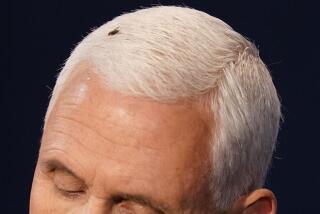Bush, Gore Campaigns Seal a Deal on Debate Formats
- Share via
WASHINGTON — George W. Bush and Al Gore reached agreement Saturday on a variety of debate formats intended to open their sessions up to a livelier, more probing series of exchanges.
Concluding three days of negotiations, representatives of the two candidates agreed to formats that will have Bush and Gore stand behind lecterns at their first debate, sit down in a talk show format at the second and field questions from the audience in a town hall setting at the third.
The formats will give the sole moderator more leeway in following up on questions and allow the candidates to have something more closely approximating an actual discussion, instead of the rigid series of timed exchanges typical of most recent presidential debates.
The intent is to “provide a more open and free-flowing exchange of views than in years past,” said the co-chairmen of the Commission on Presidential Debates, Republican Frank Fahrenkopf Jr. and Democrat Paul G. Kirk Jr.
Texas Gov. Bush, who prefers informal settings, had sought the less structured formats, and aides said the Republican nominee was pleased with Saturday’s agreement.
“These are not your typical debates,” said Ari Fleischer, a Bush spokesman. Praising the talk show format in particular, he said it will “for the first time ever place the candidates eyeball-to-eyeball, shoulder-to-shoulder and should bring some more spontaneity” to their exchanges.
Vice President Gore, the more experienced debater, was willing to give on format once Bush abandoned his objections and agreed to participate in all three 90-minute debates sponsored by the nonpartisan commission. The debates are expected to draw a far larger audience than the truncated alternatives that Bush initially sought.
“We’re very happy with the agreement,” said Douglas Hattaway, a spokesman for Democratic nominee Gore. “The American people will see the candidates in 90-minute debates available to all the [television] networks.”
The first presidential debate is set for Oct. 3, to be followed by sessions Oct. 11 and Oct. 17. A vice presidential debate, to be held Oct. 5, will follow a talk show format.
Each of the debates will start at 6 p.m. PDT. Jim Lehrer, executive editor and anchor of PBS’ “News-Hour,” will moderate the presidential debates, reprising a role he played in 1996. The moderator of the vice presidential session has yet to be chosen.
The format used for the first debate is the sort traditionally employed, with each candidate standing behind a lectern and responding to questions posed by a moderator, with a limited back-and-forth. Under one innovation agreed to Saturday, there will be a period after each question-rebuttal exchange to allow for a more open-ended discussion.
The talk show format is being used for the first time in a presidential debate and could offer the most fluid dynamic. The town hall format was employed in debates in 1992 and 1996.
Raymond Zeuschner, who teaches speech communication at Cal Poly San Luis Obispo, said the sessions are not debates in the truest sense. “In real debates, the candidates would take time to cross-examine each other, and I’m not sure anyone would want to see that.”
Zeuschner praised the variety of formats as offering the best possible opportunity to evaluate the candidates. “When you do get a candidate in a variety of circumstances, that gives you a rounder, fuller picture. . . . The [candidate] able to do the most different things will be the one who probably will come out ahead.”
The debates are likely to exclude the Reform Party’s Pat Buchanan and Green Party nominee Ralph Nader, who have failed to meet the debate commission’s criterion of registering at least 15% in national polls.
Buchanan lost a legal fight to enter the debates in a ruling released Friday by U.S. District Judge Richard Roberts, who rejected Buchanan’s claim against the Federal Election Commission.
More to Read
Get the L.A. Times Politics newsletter
Deeply reported insights into legislation, politics and policy from Sacramento, Washington and beyond. In your inbox twice per week.
You may occasionally receive promotional content from the Los Angeles Times.








